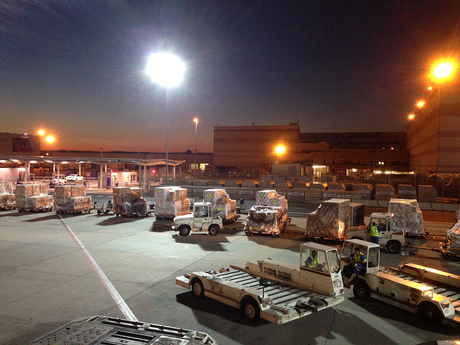Signals making airports safer for all

An airport bustles with traffic, and when a dense fog hangs over the apron, tow tractors, tankers and buses run the risk of colliding with each other or with aircraft.
In addition, tanking and loading of luggage, air cargo and catering takes significantly longer in fog or driving rain than when visibility is clear.
Plus, when the weather is bad, passengers end up sitting at departure gates longer than planned, and the schedule for cargo containers is jeopardised.
But it is hoped that poor weather will impede work on the apron far less in the future.
Researchers at the Fraunhofer Institute for Factory Operation and Automation IFF in Magdeburg, Germany, together with various European partners, are establishing the basis for this future in an EU project called ‘e-Airport’.
“We are developing a positioning system that will increase safety on the apron,” explained Olaf Poenicke, research manager at the Fraunhofer IFF. “It will additionally make it possible to utilise airport capacities more efficiently because the system allows logistical operations to run in a significantly more structured way than before.”
The European Galileo satellite system is the basis of the novel positioning system in the e-Airport project.
The principle is similar to that of an automotive navigation system: tractors and other vehicles will have receivers for GNSS signals, powered by the vehicle’s power system. The signals from the Galileo satellites and other systems such as GPS will be used to establish their exact location.
That positioning data will be sent by WLAN or cellular radio to a control centre. The control system, in turn, will send messages back to the drivers. A display will warn when a vehicle is getting too close to another, driving too close to restricted areas or leaving a specified route.
“We at the Fraunhofer IFF are contributing our expertise in air cargo to this control centre, modelling the processes and specifying the job orders received by a tow tractor driver,” explained Poenicke.
The process models help define ideal target processes. They are compared in the control centre with actual data sent from the apron by sensors. Discrepancies can thus be identified, and instructions derived from them can be sent to the drivers.
Although positioning systems that determine vehicle locations exist, they are based on GPS. This entails problems, especially in the vicinity of buildings. Shadowing occurs and data are imprecise or break off completely.
This won’t happen in e-Airport. Additional signals from the Galileo satellites and other correction signals from the European EGNOS D-GPS system will increase accuracy and reliability substantially.
In addition, up to now tractor drivers have usually received printed work assignments. Where do they have to hitch which dollies, eg, trailers loaded with air cargo pallets or containers? Where should they deliver them? Errors occur time and again. Dollies are parked on the airport premises and forgotten, for instance, and have to be laboriously hunted down later.
“Our system eliminates such errors. It knows both the desired and actual status and gives the driver pertinent work instructions,” said Poenicke.
The researchers are additionally developing special wireless sensors, which are attached to dollies. They use an energy-saving wireless protocol to send their data, eg, a trailer’s identification number and load, to a receiver unit in the tow tractor. The unit automatically analyses which dollies are hitched and relays the dolly data, together with the tow tractor’s positioning data, to the control centre.
The latest status data keeps the e-Airport system always in the know, even about the location of a dolly parked on the apron. The control centre has aggregated data not only on vehicles but also on their dollies and the cargo loaded on them.
2025–26 Thought Leaders: Tim Karamitos
Tim Karamitos from Ericsson discusses the connectivity requirements of emergency services and...
2025–26 Thought Leaders: Ruth Tovo
Comms Connect panellist Ruth Tovo, from the South Australian SES, discusses the technical...
ARCIA update: celebrating excellence in our industry
The ARCIA Annual Gala Dinner and Excellence Awards took place during the same week as Comms...



